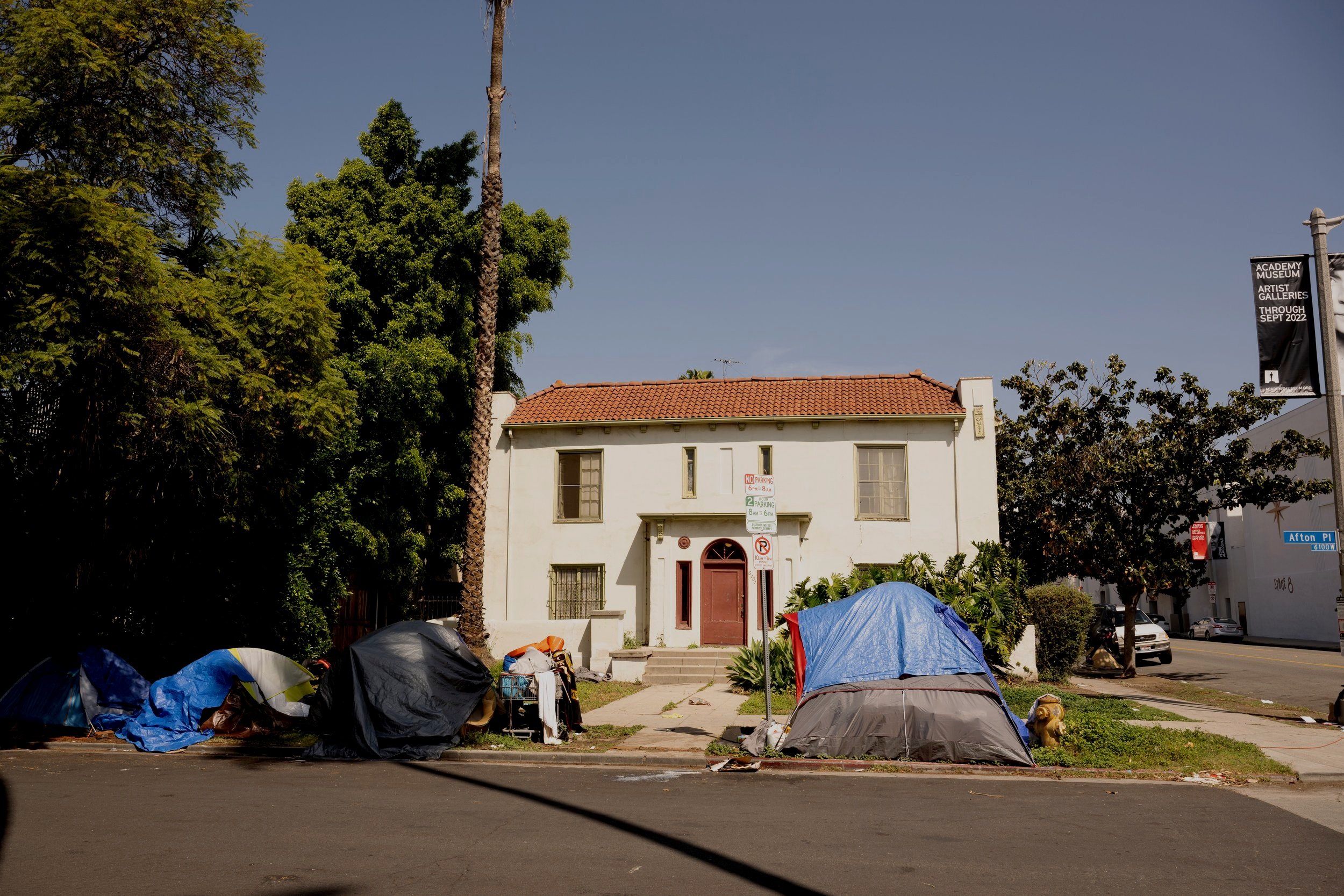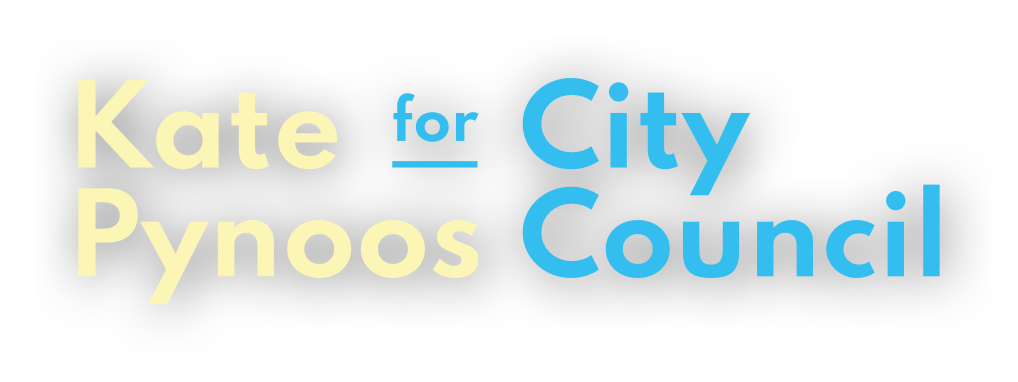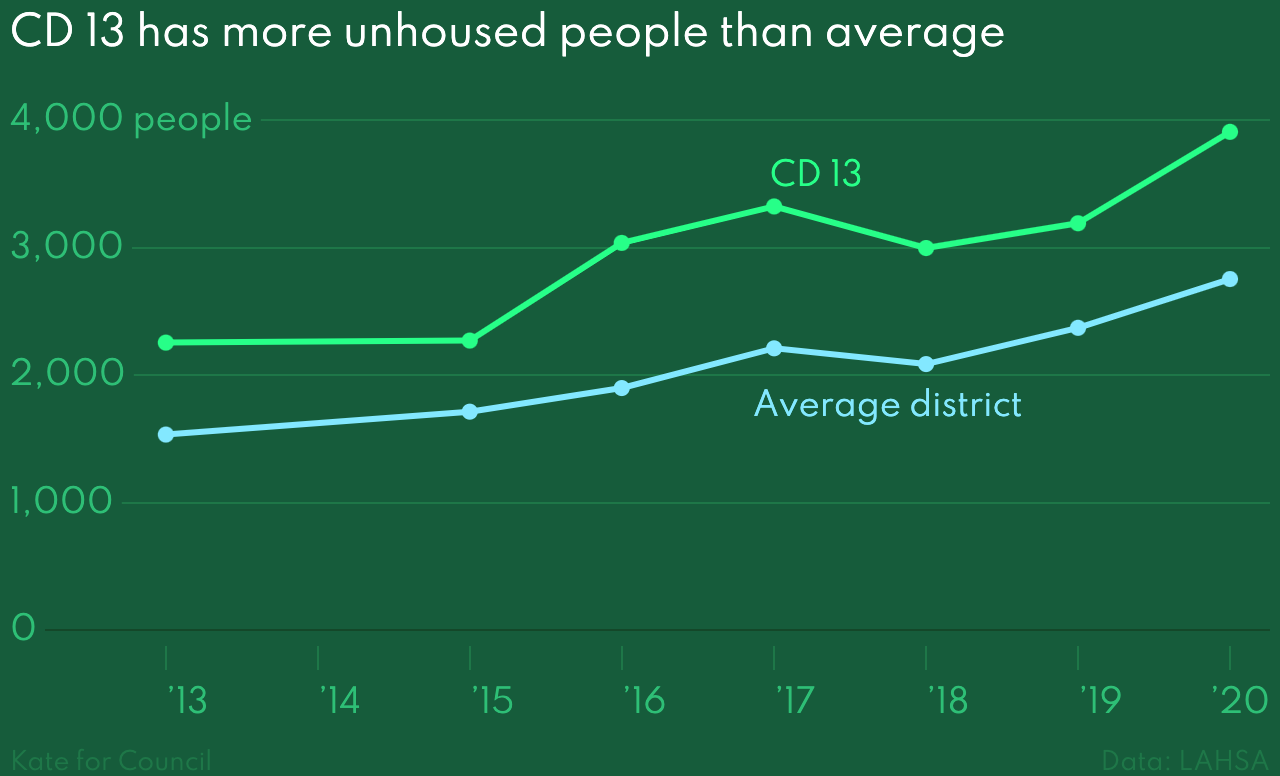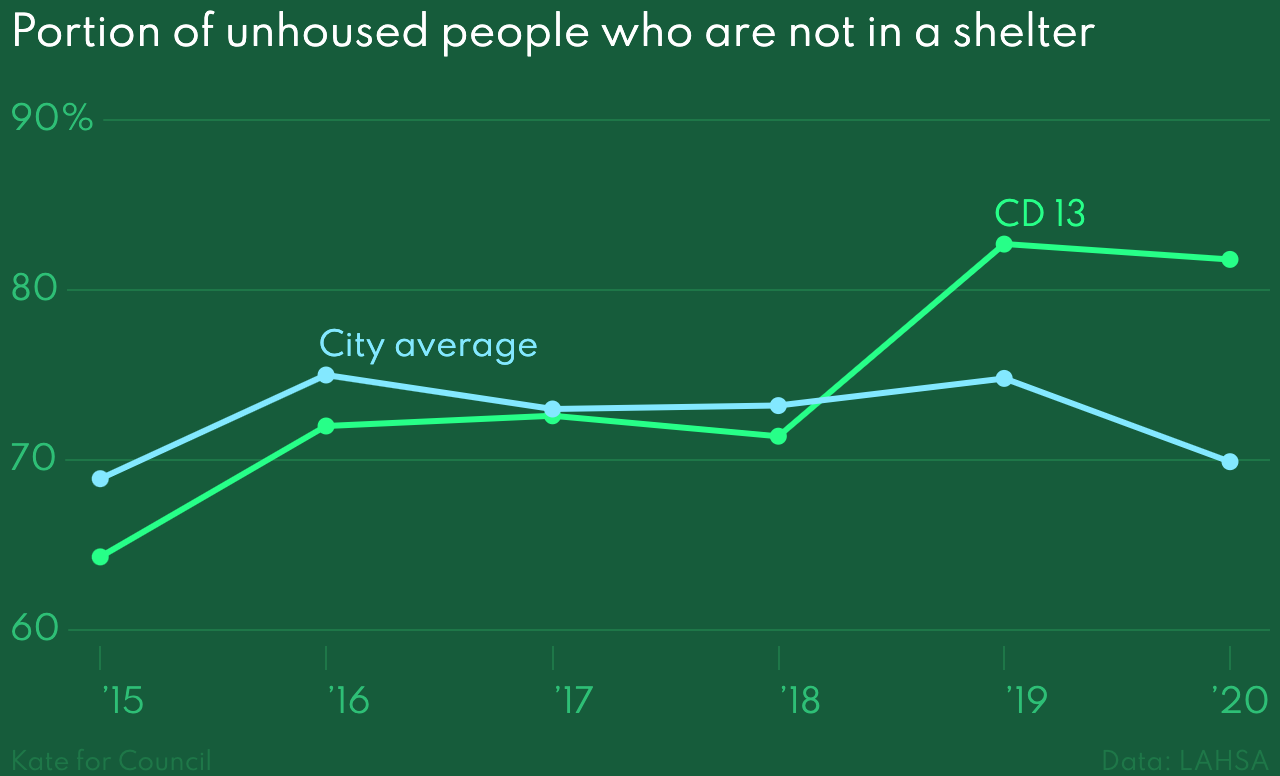
Kate Pynoos’s plan to address homelessness
In our City, there are over 41,000 people who are without a stable home, of which 3,907 (though likely more) reside in the 13th District. Homelessness has been a fixture of Los Angeles for decades because of systemic racism, rules that make housing difficult and expensive to build, the continued under-investment in mental and behavioral health services, over-policing and the failed “War on Drugs.” As the City has grown increasingly unaffordable, the number of unhoused Angelenos has skyrocketed, with homelessness nearly doubling since 2011. We are reminded of this grim reality every day, with tents and encampments in virtually every corner of the City.
Even amidst this extraordinary suffering, we know what solves homelessness—permanent housing, supportive services, and financial security—and what does not—criminalization, displacement, and inconsistent outreach that fails to build trust or offer pathways off the streets. Our homelessness crisis is a result of policy failure and inaction from our elected leaders at many levels of government. Now, as the crisis becomes even more acute, our City is doubling down on failed approaches that simply move unhoused folks from sidewalk to sidewalk, wasting taxpayer money and not getting any closer to a real solution. That must change.
While a political boundary makes no difference to someone who is trying to find a safe place to sleep for the night, solving homelessness requires all levels of government—the City, the County, the State, and the Federal Government, all of which have different roles—to be working collaboratively, transparently, and toward a common goal. All too often we see elected leaders,whether driven by political self-interest, bureaucratic inefficiency, or simply a stubborn unwillingness to work with others, pursue contradictory or separate plans that don’t actually move us closer to a Los Angeles where everyone is housed.
Permanently re-housing 41,000 Angelenos while preventing hundreds of thousands of our neighbors from falling into homelessness requires real leadership and the ability to establish trust with both housed and unhoused residents alike. As your Councilmember, I will confront this crisis head-on while centering the humanity and needs of all Angelenos. From my first day in office, I will be laser-focused on three key issues:
1. Keeping more Angelenos housed
Homelessness continues to get worse in Los Angeles because more and more people are being pushed out of their homes and onto the streets. In 2020, over 94,000 people experienced homelessness in Los Angeles County. Thanks to Measure H, Prop HHH, and recent state and federal funding, we are re-housing more people in Los Angeles than ever before—over 60,000 people in the last three years—but the system remains overwhelmed.
The situation is even more dire, as nearly half a million households in L.A. County lack access to an affordable home, while a renter needs to earn over $38 dollars an hour—2.5 times the City’s minimum wage—to afford average monthly rent. And with rent increases outpacing the rise in wages and the continued lack of a robust social safety net, far too many of our neighbors are a lost job or unexpected medical bill away from living on the streets. If we want to ever have a chance to truly end our homelessness crisis, we must act with urgency to keep more of our neighbors financially secure and stably housed.
We need to focus on keeping neighbors housed because it is the right thing to do—homelessness is often caused by trauma, while being a traumatic experience on its own—but it is also much less expensive to keep someone in their homes than helping them off the streets. We can protect people who are on the edge of homelessness from being pushed out of their homes through:
Creating a new “Office of Tenant Support” dedicated to help tenants remain housed and to provide technical assistance to tenant coalitions exploring innovative housing solutions such as community land trusts and Tenant Opportunity to Purchase (“TOPA”) programs;
Instituting and fully funding a uniform right to counsel for renters, with culturally and linguistically competent outreach to immigrant and other vulnerable communities. We can accomplish this by qualifying and then passing the “United to House L.A.” citizens’ initiative this November;
Utilizing emergency rental assistance to vulnerable tenants, even after the end of the COVID-19 pandemic;
Proactively identifying those on the brink of housing instability and flooding them with targeted services;
Expanding the number of the domestic violence (“DV”) shelter beds and resources to ensure survivors don’t need to choose between the streets and returning to an abuser;
Affirmatively addressing the nexus of houselessness and justice-involvement through criminal justice and re-entry reform;
Tackling the foster youth to homelessness pipeline by ensuring greater coordination between relevant systems;
Tracking all affordable rental units in the City to reduce the further loss of any rent-stabilized buildings.
Addressing and stopping the demolition and “flipping” of the City’s limited rent-stabilized and affordable housing units; and
Making transparent and addressing corporate ownership of residential housing to move toward the de-commodification of housing.
2. Developing an “all of the above” system for helping people move off the streets and into stable housing
Amidst this crisis, one thing remains clear—permanent housing, coupled with services tailored to an individual’s needs, is what helps people come off the streets, regain personal stability, and stay housed. Simply put, permanent housing ends homelessness. Unfortunately, it is expensive and time-intensive to build, made worse by the City’s bureaucracy and inaction from local politicians. Meanwhile, an average of 4-5 Angelenos die on the streets each day.
In the last few years, several short-term housing solutions have popped up across the City, designed to help folks transition off the streets before entering more stable housing. However, given our continued lack of affordable housing, many of these interventions can be a dead-end, with people staying in them longer than expected or simply falling back onto the streets.
This is why we need to continue developing an “all of the above” system, whose final goal is moving people to permanent housing solutions while creating a pipeline of housing options that can help individuals quickly transition off the streets. “Permanent housing vs. shelter” is the wrong conversation to be having – we need both, and an array of programs and services that address the complex needs of our unhoused neighbors.
To further refine this spectrum of housing solutions, we must:
Make all affordable and homeless housing projects subject to ministerial approval through City Planning, and free from meddling by councilmembers;
Create an “Affordable and Supportive Housing” division with both the Housing and Planning departments to exclusively focus on expediting affordable and homeless housing projects;
Exempt all affordable and homeless housing projects from frivolous lawsuits;
Accelerate the conversion of formerly commercial and City-owned property into housing through adaptive reuse;
Pass a “Right to Housing” framework for the City of Los Angeles;
Strengthen collaboration between the City, the County, and the Los Angeles Homeless Services Authority (“LAHSA”) to ensure that Angelenos placed in short-term housing options have clear plans to transition into more permanent and stable housing;
Pass S.B. 679, to create the Los Angeles County Affordable Housing Solutions Agency (“LACAHSA”), to finance the development and preservation of affordable housing across L.A. County;
Support the “Ending Homelessness Act of 2021” (H.R. 4496) to make housing choice vouchers a universal right;
Invest in alternative housing models, such as shared housing, social housing, community land trusts, and Tenant Opportunities to Purchase Act programs (TOPAs).
Create new funding mechanisms for affordable housing, such as the “United to House L.A.” citizens initiative and the creation of a public bank
Double down on incentives to develop affordable housing and commit to meeting our RHNA targets
3. Implementing a streets engagement strategy that connects unsheltered Angelenos with services and pathways to permanent housing
One of the most public ways we are confronted with homelessness each day are the tents we see scattered across the City. Since the start of the pandemic, encampments have seemed to grow dramatically. The ugly truth, though, is that these Angelenos were living on our streets well before March 2020. In fact, 70% of all people who are experiencing homelessness in the City of Los Angeles are unsheltered, meaning they live in tents, parks, cars, sidewalks, or some other location not intended for human habitation.
For our 3,194 unsheltered neighbors in CD-13 and the nearly 29,000 Angelenos across the City, we can balance access to public space without resorting to displacement by implementing a comprehensive street engagement strategy that offers trauma-informed service provision tied to pathways to permanent housing. A successful strategy, based off the “Encampment to Home” pilots led by service providers and championed by Councilmembers Bonin and Raman, will set clear guidelines about how we direct resources and programs to encampments while establishing clarity for both housed and unhoused residents, and in a way that is driven by the actual needs of the community.
While some of this work is already underway, there is more to be done. We must:
Ensure the proposed “Comprehensive Streets Engagement Strategy” is fully and consistently implemented across the entirety of the City;
Bring together LAHSA and relevant County departments to develop a unified outreach and engagement strategy that coordinates the numerous engagement teams and sets clear measures and objectives;
Increase the number of specialized outreach teams that can address specific needs, like domestic / intimate partner violence, mental and behavioral health, and substance abuse;
Leverage new federal and state dollars to fund housing placements and vouchers for those living in encampments, so they can transition to permanent housing;
Build off the efforts of Councilmembers Bonin and Raman to implement voluntary sanitation cleanups, where City workers and outreach teams work with unsheltered residents to ensure encampments are clean and safe;
Address the continually unmet need of unsheltered residents by expanding hygiene and sanitary infrastructure, scaling the deployment of street medicine teams, and legalizing overdose prevention sites through SB 57 (Wiener);
Repeal LAMC 41.18 and 56.11, which continue to criminalize poverty and push Angelenos further to the margins;
Implement a Commission on Lived Experience that can inform the Council on solutions and programs that fully address the needs of unsheltered individuals.
It is no stretch to say that homelessness is the moral, social, economic, and political crisis facing Los Angeles today. The extraordinary scale and depth of the human suffering, in one of the richest cities in the world, can often make the issue seem unsolvable, even as we’ve voted in the last few years to fund new housing and services. And because of failed leadership in City Hall, which has once again decided to rely on the failed and costly practices of criminalization, it also feels like we are moving away from actually solving the underlying issues.
Even so, the truly herculean and unheralded work done every day by service providers, volunteers, and activists shows us that with sufficient political courage, robust services, and direct pathways to permanent housing, we can in fact bring our neighbors indoors and permanently break the cycle of houselessness. As your Councilmember, I will never shy away from making the hard decisions that move our district and our City toward a future where everyone has a place they can call home.



